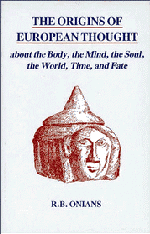Book contents
- Frontmatter
- Contents
- Preface to the first edition
- Preface to the second edition
- Introduction: The Earliest Greeks
- PART I THE MIND AND THE BODY
- Chapter I Some Processes of Consciousness
- Chapter II The Organs of Consciousness
- Chapter III The Stuff of Consciousness
- Chapter IV Cognition—The Five Senses
- Chapter V The Liver and the Belly
- PART II THE IMMORTAL SOUL AND THE BODY
- PART III FATE AND TIME
- ADDENDA
- Indexes
Chapter II - The Organs of Consciousness
Published online by Cambridge University Press: 06 August 2010
- Frontmatter
- Contents
- Preface to the first edition
- Preface to the second edition
- Introduction: The Earliest Greeks
- PART I THE MIND AND THE BODY
- Chapter I Some Processes of Consciousness
- Chapter II The Organs of Consciousness
- Chapter III The Stuff of Consciousness
- Chapter IV Cognition—The Five Senses
- Chapter V The Liver and the Belly
- PART II THE IMMORTAL SOUL AND THE BODY
- PART III FATE AND TIME
- ADDENDA
- Indexes
Summary
The general internal anatomy of men and beasts must have been familiar to all through battle and sacrifice or the domestic killing and dressing of animals; but the true functions of the several organs, with the exception of the alimentary canal and its obvious accessories, were not known. Let us look for the seat of consciousness. Where is it in the body? A man is said to think his thoughts and feel emotions and impulses in his heart (κῆρ or κραδίη) but more usually in the ϕρένες, sometimes called πραπίδες, and in the θυμός. What are these? In the latter half of the fifth century the Hippocratic school gave the name ϕρένες to the midriff or diaphragm and Plato in the Timaeus did so too. Later writers, ancient and modern, have therefore assumed that this must have been the meaning for Homer also, while the θυμός, apparently something ‘vaporous’ (cf. θυμιάω, etc.) which the ϕρένες are said to contain, is interpreted as the ‘blood-soul’. But no part of the body has less obvious claims to be the seat of the ‘blood-soul’, if such is in point, or indeed of the intelligence, than the midriff or diaphragm, the pink muscular sheet dividing the organs of the thorax from those of the abdomen. Nor has that sheet any claim to be considered as a plurality, ϕρένες, or, as the latter are, to be described as μέλαιναι (or ἀμϕιμέλαιναι), ‘black’, ‘blackish’, or whatever that means.
- Type
- Chapter
- Information
- The Origins of European ThoughtAbout the Body, the Mind, the Soul, the World, Time and Fate, pp. 23 - 43Publisher: Cambridge University PressPrint publication year: 1988

